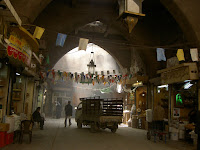Avoiding Iraq provided a great excuse to be distracted from the trade route by one of the finest medieval castles in the world - Krak des Chevaliers. In the 12th Century, the Crusaders took an existing fort and so successfully improved its fortifications that it held out against Saracen attack for over a hundred years. When it finally surrendered, marking the end of the Christian control of the Holy Land, it was again strengthened by a second defensive wall.
Rolling thunder and lightning flashes provided a dramatic setting as we walked up to this huge, imposing castle which is perched on top of the hill. We spent several hours exploring the maze of rooms and corridors before walking around the battlements, from which there was spectacular view of the lush green Syrian plains stretching out below.

We continued north to Aleppo. Now Syria's second city, it's success on the Silk Road is illustrated by the fact that it now houses the world's largest bazaar. This city of a thousand mosques is also one of the more religiously diverse in the Middle East, with Christians making up nearly half of its population. That it is one of the few remaining examples of sustained religious co-existence that William Dalrymple finds on his travels in the Middle East forms the basis of his strongly argued book, From the Holy Mountain.

Aleppo's rich history collides with the present just beyond its impressive citadel and the labyrinthine bazaar. There must be a yellow taxi for every one of the thousand mosques in Aleppo (and 1000 satellite dishes...). Crossing busy three lane roads with no traffic lights and certainly concept of pedestrian right of way is an experience.. you simply walk out, confidently, into the oncoming stream of traffic and miraculously the cars flow around you. A certain understanding of Syrian road etiquette is required, however - if you attempt to walk in front of a car that has already slowed for someone ahead of you, it will accelerate straight at you.
Once this lesson was complete, Aleppo was a pleasure to explore: in my view it somehow managed to surround its ancient core with a more characterful bustling modernity than Damascus. In addition, it has some excellent restaurants and 25p fresh fruit smoothies to keep the energy levels up as you wander around.
We were sad to leave Aleppo and Syria and with them the Arabic section of our journey. Our brief introduction to Syria and Lebanon had been captivating. We had scratched the surface of an embarrassment of cultural riches (and at the same time scratched our own heads at the extraordinarily haphazard approach taken to conservation and heritage) and had found a warm and welcoming people (unsolicited, we had be given lifts by a Beiruti couple and an Aleppan man and housed and fed by some Syrian teachers). Syria, in particular, is without doubt a hidden gem; I would wholeheartedly recommend it to anyone!

1 comment:
Dear Michael,
Many thanks for your very interesting reportage on your way north towards Constantinople. I enjoyed it very much.
I have a question concerning your truncated trip to the east to Babylon. What other cities lay beyond Babylon in order to arrive at the city of Cathay in China? Any reference leads?
Thank you,
Lichia
Post a Comment